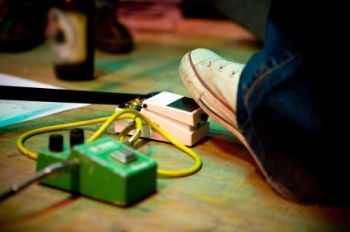Find the right pedal, guitar effects!
Contents |
Introduction
Despite being an important aspect of every electric guitarist's life, most beginners have little or no knowledge about them. Simply put, guitar effects are nothing but electronic devices used to alter or moderate the pitch, sound, or tone of an electric guitar while playing popular genres of music such as heavy metal, rock, and blues. Guitar effects housed in guitar pedals are quite common and easily available both online and offline.
Also called as distortion pedals, these effects are popular among both professional as well as budding guitarists across the globe. As the name suggests, guitar effect pedals can be used to attain number of effects such as overdrive, flanging, distortion, fuzz, reverberation, wah-wah, and chorus. Although they are primarily being used by guitarists and keyboard players, even instrumentalists such as violinists have now started using them.
Distortion related effects
This effect, which happens to be a hallmark of rock and heavy metal guitar music, is produced by means of a distortion pedal that clips the signal and distorts its waveform leading to a distortion in the sound produced. While there are various types of distortion effects, each one differs from the other due to its distinct characteristics and features.
Overdrive distortion
This type of distortion is produced by creating a high gain sound. This type of distortion is extremely popular and can be created with distortion pedals such as Pro Co Rat, Digi Tech Hot Tech, and Marshall Guv’Nor. Marshall has gone a step further in creating this high gain sound by creating a sound that experts would call as total distortion or saturated gain.
Fuzz pedals
This kind of pedals is very popular among guitarists who use it to recreate the magic of the classic sound of the 60's overdrive tube amp combined with torn speaker cones. However, the original fuzz pedals are being replaced everywhere with more sophisticated designs that can produce effects such as gating and octave. Dallas Arbiter Fuzz Face would be your best bet if you were looking for good Fuzz effect pedals.
Hi Gain
The high gain amplification used in electric guitars can be credited for this effect for its typical sound that was produced by overdriven amp tubes or a distortion pedal. Modern pedals used for this purpose create a thick sound that is so unique that no other device can produce it. Go for the Boss ML2 metal core if you were looking for a pedal to create hi gain effect.
Filtering related effects
Equalizer
An equalizer is employed for the purpose of altering the frequency response in various frequency regions. While most music player software use the graphic equalizer that offers slider interface, in a guitar these sliders are replaced by a rotary control to adjust the level of the frequency band. Examples of this type include MXR M-108 10-band Equalizer, Boss GE-7 Equalizer, and Danelectro Fish 'n Chips.
A phase shifter
It is used to create a 'whooshing' sound something similar to that of a flying jet.
Wah pedal
It is a foot-operated pedal used to create a sound similar to a person saying 'wah' by allowing only a small portion of the frequencies of the incoming signal to pass through. The back and forth rocking action of the pedal ensures that low and high frequencies are passed through alternately to produce the desired effect. The Dunlop Cry Baby and the VOX V847 Wah are some of the wah pedals you may consider.
Volume related effects
Volume Pedal
Basically a foot operated potentiometer, the volume pedal can be tilted in forward and backward direction to enable the guitarist to control the volume of his instrument during a performance. Apart from volume control, it also allows the guitarist to create a fading effect. Pedals to consider include Ernie Ball Stereo Volume Pedal, Boss FV-50H Foot Volume, and VOX V850 Volume Pedal.
Tremolo
Tremolo works like an auto-volume knob to create a shuddering sound similar to the one that is caused due to turning the volume up and down rapidly. Examples of this type include Voodoo Lab Tremolo, Boss TR-2 Tremolo, and Electro-Harmonix Pulsar.
Compressor
This one acts like an automatic volume control that reduces the input level as the outgoing signal gets louder and vice versa. Compressors can have a huge impact on the behavior of other effects especially distortion related effects. Boss CS-3 Compression Sustainer and MXR M-102 DynaComp are some of the popular pedals under this category.
Why guitar effects pedals score over rack mount processors
According to most musicians, the traditional guitar effects pedals are believed to offer the best bang for the buck. Large touring rock bands however tend to depend on both processors and pedals to attain the desired sound effects. While contemporary guitarists are turning to digital multi-effects processors to achieve a combination of effects like reverb, delay, chorus, distortion into patches and banks to be used later, this method has certain disadvantages.
The first drawback is that the combination effects and related parameters like reverb decay, amount of delay, etc can't really be changed in a jiffy as most people would love to believe. In addition, it’s not very useful during live gig due to the slight sound dropout that can be quickly noticed especially while sustaining a long chord. On the other hand guitar effect pedals gives you much more flexibility in terms of switching on and off individual effects as desired.
Analog effects pedals are still the choice of many a musicians who simply love the 'warmer' tone they provide. Using guitar effects pedals has become easier due to pedalboard style case that eliminates the need of reconnecting stompboxes every time you wish to play. Pedalboards may also come with power supplies so that you don’t have to run around changing batteries every time.






